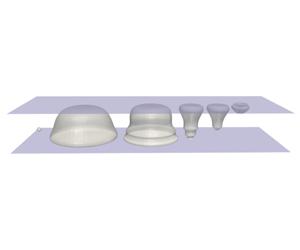Journal of Fluid Mechanics ( IF 3.7 ) Pub Date : 2020-06-08 , DOI: 10.1017/jfm.2020.356 Qingyun Zeng , Silvestre Roberto Gonzalez-Avila , Claus-Dieter Ohl

|
We study the dynamics of cavitation bubbles and induced jets in a thin liquid gap bounded by two rigid walls. The bubbles are generated experimentally with a focused laser pulse and are compared to simulations. The gap height  $H$
and the distance of the position of bubble nucleation
$H$
and the distance of the position of bubble nucleation  $h$
with respect to the nearest wall are varied. The bubble dynamics is recorded at 500 000 frames per second and is compared to simulation results from the compressible volume of fluid solver based on OpenFOAM that takes into account viscosity and surface tension. Good agreement of the spatio-temporal bubble dynamics between experiments and simulations is obtained. The findings are that the parameter space consists of three regions with distinct jetting dynamics that are characterized by two dimensionless parameters: the normalized gap height,
$h$
with respect to the nearest wall are varied. The bubble dynamics is recorded at 500 000 frames per second and is compared to simulation results from the compressible volume of fluid solver based on OpenFOAM that takes into account viscosity and surface tension. Good agreement of the spatio-temporal bubble dynamics between experiments and simulations is obtained. The findings are that the parameter space consists of three regions with distinct jetting dynamics that are characterized by two dimensionless parameters: the normalized gap height,  $\unicode[STIX]{x1D702}=H/R_{max}$
, where
$\unicode[STIX]{x1D702}=H/R_{max}$
, where  $R_{max}$
is the spherical equivalent radius of the bubble at maximum expansion, and the normalized stand-off distance of the bubble measured from the centre of the gap,
$R_{max}$
is the spherical equivalent radius of the bubble at maximum expansion, and the normalized stand-off distance of the bubble measured from the centre of the gap,  $\unicode[STIX]{x1D701}=(H/2-h)/R_{max}$
. The three qualitatively distinct jetting behaviours are the transferred jet impacting on the distant wall, the double jet as a result of a bubble splitting and impacting on both walls and the directed jet from a conically shaped bubble impacting on the closest wall. The impact velocity of the liquid jets onto the walls can reach more than
$\unicode[STIX]{x1D701}=(H/2-h)/R_{max}$
. The three qualitatively distinct jetting behaviours are the transferred jet impacting on the distant wall, the double jet as a result of a bubble splitting and impacting on both walls and the directed jet from a conically shaped bubble impacting on the closest wall. The impact velocity of the liquid jets onto the walls can reach more than  $200~\text{m}~\text{s}^{-1}$
and strongly depends on the gap height and bubble position. The simulations reveal that the viscous boundary layers affect the bubble splitting and therefore the directions of jetting. Additionally, we found that with increasing length of the thin gap
$200~\text{m}~\text{s}^{-1}$
and strongly depends on the gap height and bubble position. The simulations reveal that the viscous boundary layers affect the bubble splitting and therefore the directions of jetting. Additionally, we found that with increasing length of the thin gap  $L$
the bubble oscillation period increases and converges for sufficiently large gaps.
$L$
the bubble oscillation period increases and converges for sufficiently large gaps.
中文翻译:

细小间隙中空化气泡的分裂和喷射
我们研究了由两个刚性壁为边界的薄液隙中的空化气泡和诱导射流的动力学。气泡是通过聚焦激光脉冲通过实验产生的,并与模拟进行比较。间隙高度
$ H $
和气泡成核位置
$ h $
的距离
 关于最近的墙壁是变化的。以每秒50万帧的速度记录气泡动力学,并将其与基于OpenFOAM并考虑了粘度和表面张力的可压缩体积的流体求解器的模拟结果进行比较。实验和模拟之间获得了时空气泡动力学的良好一致性。结果发现,参数空间由具有不同喷射动力学的三个区域组成,这些区域具有两个无量纲参数:标准化间隙高度
$ \ unicode [STIX] {x1D702} = H / R_ {max} $
,其中
$ R_ { max} $
是气泡在最大膨胀时的球面等效半径,并且是从间隙中心测得的气泡的标准化支撑距离,
关于最近的墙壁是变化的。以每秒50万帧的速度记录气泡动力学,并将其与基于OpenFOAM并考虑了粘度和表面张力的可压缩体积的流体求解器的模拟结果进行比较。实验和模拟之间获得了时空气泡动力学的良好一致性。结果发现,参数空间由具有不同喷射动力学的三个区域组成,这些区域具有两个无量纲参数:标准化间隙高度
$ \ unicode [STIX] {x1D702} = H / R_ {max} $
,其中
$ R_ { max} $
是气泡在最大膨胀时的球面等效半径,并且是从间隙中心测得的气泡的标准化支撑距离,

 $ \ unicode [STIX] {x1D701} =(H / 2-h)/ R_ {max} $
。三种在质量上截然不同的喷射行为是:转移的射流撞击在远处的壁上;由于气泡分裂并撞击在两壁上而产生的双重射流;以及圆锥形气泡撞击到最近的壁上的定向射流。液体喷射到壁上的冲击速度可以达到
$ 200〜\ text {m}〜\ text {s} ^ {-1} $以上,
并且在很大程度上取决于间隙高度和气泡位置。仿真表明,粘性边界层影响气泡的破裂,从而影响喷射的方向。另外,我们发现,随着细间隙
$ L $
的长度增加,气泡振荡周期增加并且对于足够大的间隙收敛。
$ \ unicode [STIX] {x1D701} =(H / 2-h)/ R_ {max} $
。三种在质量上截然不同的喷射行为是:转移的射流撞击在远处的壁上;由于气泡分裂并撞击在两壁上而产生的双重射流;以及圆锥形气泡撞击到最近的壁上的定向射流。液体喷射到壁上的冲击速度可以达到
$ 200〜\ text {m}〜\ text {s} ^ {-1} $以上,
并且在很大程度上取决于间隙高度和气泡位置。仿真表明,粘性边界层影响气泡的破裂,从而影响喷射的方向。另外,我们发现,随着细间隙
$ L $
的长度增加,气泡振荡周期增加并且对于足够大的间隙收敛。



























 京公网安备 11010802027423号
京公网安备 11010802027423号